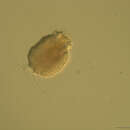Loriciferans are microscopic animals living between the particles of marine sediments. Discovered in 1983 off the coast of France by the Danish zoologist R. M. Kristensen, about 100 species have so far been collected, though (as of 2010) only a third of those have been described. Researchers continue to find new species, indicating that this is an abundant and cosmopolitan taxon, with worldwide distribution and occurring in sediments from shallow to deep water. Loricifera are interesting as “masters of miniturization” (Rundell & Leander 2010) but also as “the first evidence of a metazoan life cycle that is spent entirely in permanently anoxic sediments” (Danovaro et al 2010).
Loriciferans are similar in size to large single-celled protozoans (< 0.5 mm) but are multicellular, with about 10,000 specialized cells creating a tiny but complex body with a brain, digestive and excretory systems, specialized appendages, sense organs, musculature and locomotory functions, separate sexes, and a protective external cuticle (the “lorica”) into which the “introvert” containing the mouth cone and head can be retracted (Ruppert et al 2004).
Characteristics of the Phylum Loricifera KRISTENSEN 1983
Marine metazoans
ADULTS
- Size: 115 to 425 micrometers long
- Symmetry: bilateral
- Autapomorphic characteristics:
- body divided into 5 regions: mouth cone, heat (introvert), neck, thorax, abdomen
- Internal buccal armature arranged in strict tri- or hexagonal pattern
- Nine rows of sensory or locomotory appendages (scalids), each with muscles attached to introvert
- First row of scalids consists of 8 multicellular club-shaped or blunt-tipped clavoscalids of various shapes and number
- Second to ninth rows of scalids consist of spinoscalids of various shapes and numbers
- Neck consists of 3 rows of basal plates and 1 row of trichoscalids
- trichoscalids are flattened and serrated, with either 15 single or 7 double, alternating with 8 sincle trichoscalids
- Thorax is accordion-like and without appendages
- Abdomen covered with a more-or-less cuticularized lorica with 6 to 10 plates or 22 to 40 plicae
- Mouth cone is not eversible but protrusible
- Mouth cone and head can be retracted into the loricated abdomen
HIGGINS LARVAE
- Size: 48 to 780 micrometers long
- Body plan: same regions as adult
- Autapomorphic characteristics:
- Mouth cone sometimes with a midventral seta and/or 6 to12 oral stylets and, when present, internal armature in strict tri- or hexagonal pattern
- Eversible introvert with 8 clavoscalids and up to 7 rows of spinoscalids
- Neck used as closing apparatus
- Accordion-shaped thorax has plated formed from transverse and longitudinal folds
- Lorica is longitudinally folded
- Two or 3 locomotory setae are present ventrally between thorax and abdomen
- Toes located caudally
- Two or 3 sensory setae present on posterior part of lorica
- Several larval instars, growing by a series of molts
(summarized from Kristensen et al 2007)
Partial list of described Loricifera
Pliciloricidae
-
Pliciloricus (1986)
-
Pliciloricus enigmaticus (1986)
-
Pliciloricus dubius (1986)
-
Pliciloricus gracilis (1986)
-
Pliciloricus orphanus (1986)
-
Pliciloricus profundus (1986)
-
Pliciloricus leocaudatus (2005)
-
Pliciloricus shukeri (2005)
-
Pliciloricus cavernicola (2009) – from submarine caves; New South Wales, Australia
-
Rugiloricus (1986)
-
Rugiloricus carolinensis (1986)
-
Rugiloricus cauliculus (1986)
-
Rugiloricus ornatus (1986)
-
Rugiloricus polaris (2005) – in clayish sediment; 1,210 m depth; Laptiv Sea (Arctica)
-
Rugiloricus bacatus (2008)
Nanaloricidae
-
Nanaloricus
-
Nanaloricus mysticus (1983) type species – in shelly gravel (Dentalium sand); 25-30 m depth; off Roscoff, France
-
Nanaloricus khaitatus (1998) – shallow intertidal and subtidal; Livorno, Italy
-
Nanaloricus gwenae (2007) – in coarse sand and shell habitats (Amphioxus sand); 15-17 m depth; 6-7 miles (9.7-11.3 km) off Fort Pierce, FL, USA
-
Armorloricus
-
Armorloricus elegans (2004) – in very clean shelly hash (Polygordius sand); 50 to 55 m depth; from Trezen ar Skoden, Roscoff (near type species)
-
Armorloricus davidi (2004) – in very clean shelly hash (Polygordius sand); 50 to 55 m depth; from Trezen ar Skoden, Roscoff (near type species)
-
Armorloricus kristenseni (2004) – from the Faroe Bank
-
Pheniciloricus
-
Phoeniciloricus simplidigitatus (2004) – 1813 m depth; near Kilinailau Trench off Papua New Guinea
-
Spinoloricus (2007)
-
Spinoloricus turbatio (2007) – from the “deep sea”; Galapagos Spreading Center
-
Australoricus (2009)
-
Australoricus oculatus (2009) – from submarine caves; New South Wales, Australia
(Higgins & Kristensen 1986, Heiner 2004, Gad & Arbizu 2005, Heiner 2005, Heiner & Neuhaus 2007, Kristensen et al 2007, Heiner et al 2009))
Undescribed species of obligate anaerobic Loricifera (Danovaro et al 2010): From anoxic hypersaline sediment; L’Atalante basin (Mediterranean Sea); >3000 m deep
-
Spinoloricus nov. sp.
-
Rugiloricus nov. sp.
-
Pliciloricus nov. sp.

